Themes: explore further
View all Close all
The 'Devil's Acre'
The hospital at this period was located at Hyde Park Corner: the site was not closed until 1980. The building still stands, but instead of a hospital it now houses a luxury hotel. Knightsbridge, Kensington, Chelsea, St James’s, Mayfair, Soho – these days that part of London doesn’t suggest the working class population that the occupational data highlights here. But although Hyde Park Corner, then as now, had an abundance of large, wealthy households, these houses required servants, as well as people working in the local shops and factories. Some of the areas which we may now connect with wealth and opulence were not always like that; the notorious slum around Westminster, for instance, was dubbed the ‘Devil’s Acre’ by Charles Dickens.
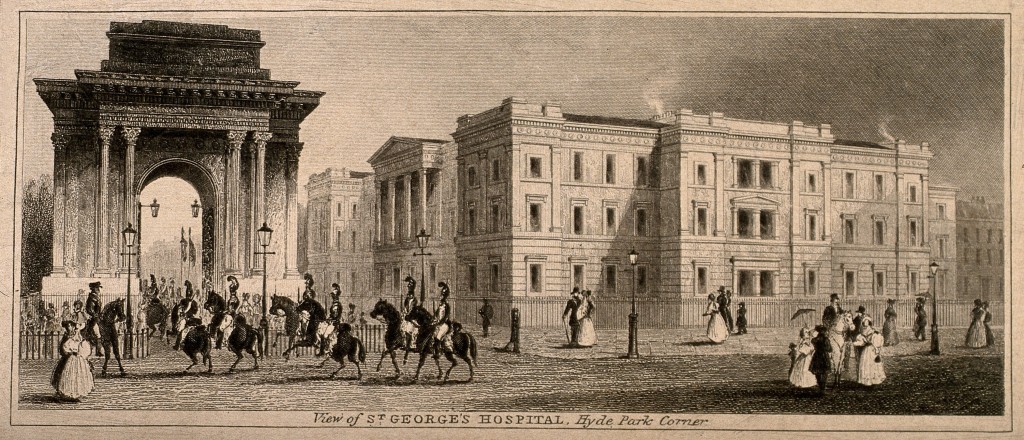 St George’s Hospital and the Constitution Arch, Hyde Park Corner. Engraving. Credit: Wellcome Collection. Attribution 4.0 International (CC BY 4.0)
St George’s Hospital and the Constitution Arch, Hyde Park Corner. Engraving. Credit: Wellcome Collection. Attribution 4.0 International (CC BY 4.0)
The so-called poverty map by Charles Booth, a businessman and social reformer, published 1886-1903, shows the area around Hyde Park to be largely wealthy and middle class, but towards Westminster and Chelsea there are areas in which the population is classed from ‘poor’ to ‘very poor, casual. Chronic want’ and ‘lowest class. Vicious, semi-criminal’.
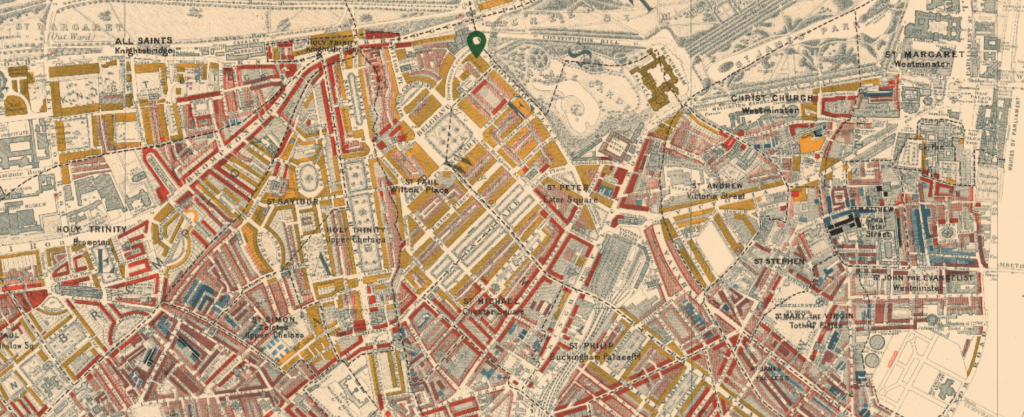 Charles Booth’s poverty map of the area around Hyde Park Corner. Source: Charles Booth, © 2016 London School of Economics and Political Science. Map data © OpenStreetMap contributors.
Charles Booth’s poverty map of the area around Hyde Park Corner. Source: Charles Booth, © 2016 London School of Economics and Political Science. Map data © OpenStreetMap contributors.
The class divisions were stark: if you were wealthy enough, you would pay for a doctor to visit you at home, or attend their private practices. Only those who could not afford it went to the hospitals, went to the hospitals, which were often filthy and unhygienic.
There are occasional exceptions to this rule in the post mortem records: among the occupations of the hospital patients we find some gentlemen, a couple of ladies, an admiral and a naval commander, for instance.
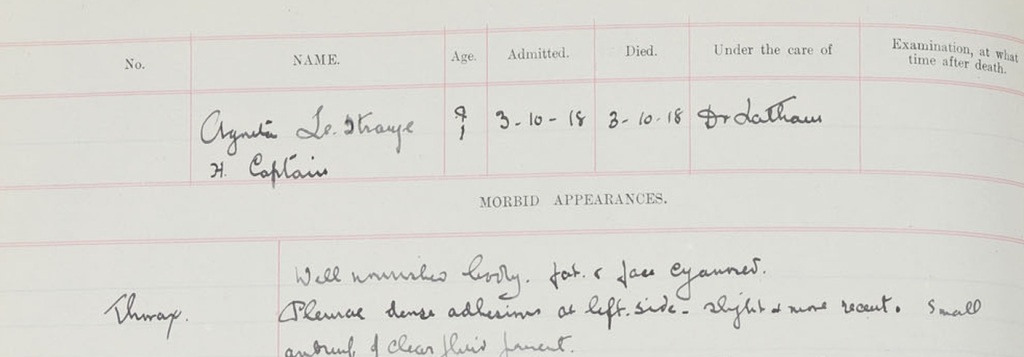 Post Mortem record of Agneta Le Strange, 3 Oct 1918, PM/1918/207. Post Mortem Casebooks, Archives and Special Collections, St George’s, University of London
Post Mortem record of Agneta Le Strange, 3 Oct 1918, PM/1918/207. Post Mortem Casebooks, Archives and Special Collections, St George’s, University of London
But looking further into these cases, they all turn out to be accidents or a sudden disease. The evocatively named Agneta le Strange was brought to the hospital unconscious by the police in 1918 after suffering a sudden brain haemorrhage; not a heroine in a gothic novel or a wizard as her name might suggest, Agneta was presumably visiting the family’s London townhouse in Eaton Square (the family also had a mansion in Norfolk).
In the majority cases, the bodies, though recorded in the post mortem volumes, were not autopsied, as that was another marker of social status: the choice to not have a post mortem. H.J. Blagrove, a ‘gentleman’, was ‘flung from his horse near the hospital’ in 1854, but his relatives asked that his body would not be examined, apart from his skull, which had been injured in the accident.
Towards mid-21st century we see a change in the kinds of occupations recorded for the patients at St George's. Attitudes towards hospitals had improved alongside with improvements in hygiene and medical advancements, and the local area was losing much of its earlier working-class populations.
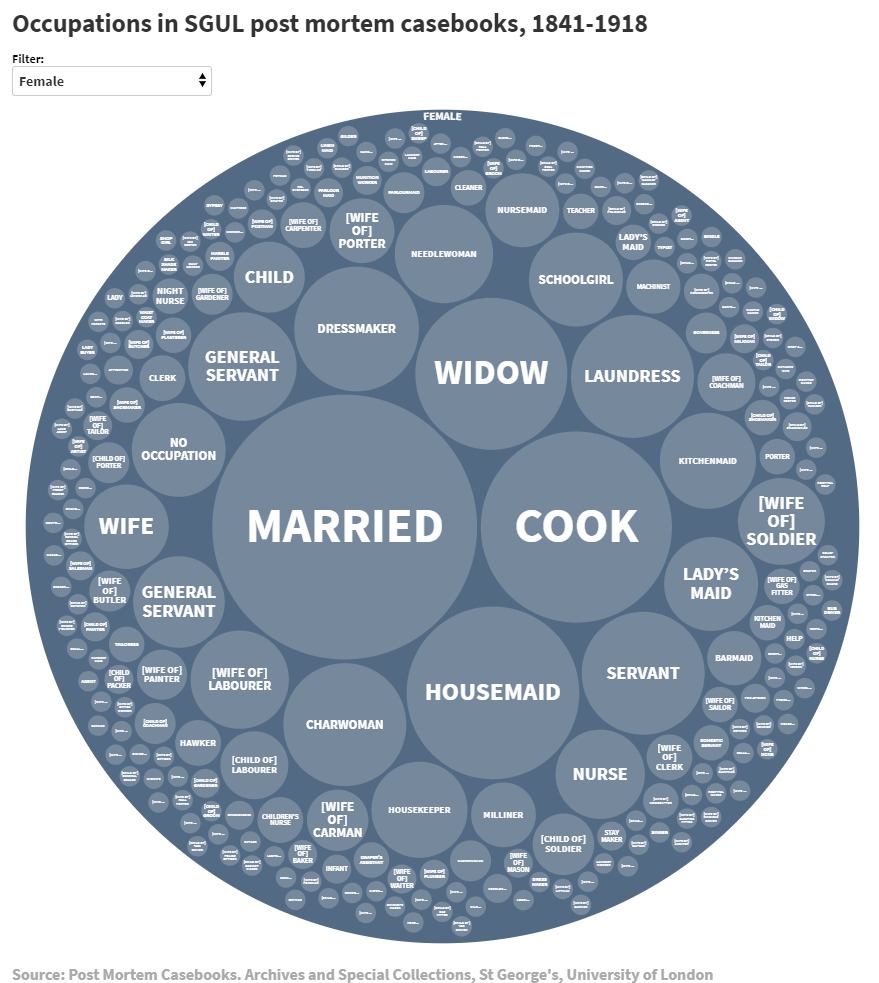 Women’s occupations in SGUL post mortem examination books, 1841-1918. Source: Post Mortem Casebooks, Archives and Special Collections, St George’s, University of London. By Juulia Ahvensalmi
Women’s occupations in SGUL post mortem examination books, 1841-1918. Source: Post Mortem Casebooks, Archives and Special Collections, St George’s, University of London. By Juulia Ahvensalmi
Women did not have many occupations open to them on their own right. When in employment, they were, by and large, working with textiles as dressmakers, needlewomen and milliners, and in domestic service, as servants, housemaids, cooks, laundresses and cleaners. Towards the late 19th century industrialisation means some other occupations become available for women, such as working in factories, and in particular during the First World War we start seeing clerks, secretaries and typists among the women. Lilly Grundy, 19, is recorded as having been a ‘machinist’, probably in a shoe factory. For unmarried women with children, the options were even fewer, and for most of the 19th century limited to dressmaking and cleaning. The post mortem records usually note the occupation of the father for the children; recording the occupation of the mother instead signals to the reader that the mother was unmarried. The mother of Edwin Cannon, aged 4 in 1887, was a charwoman (or cleaner), and the mother of Pat Gurney, aged 5 in 1917, was a flower seller, indicated in the post mortem records by ‘M’ for ‘mother’.
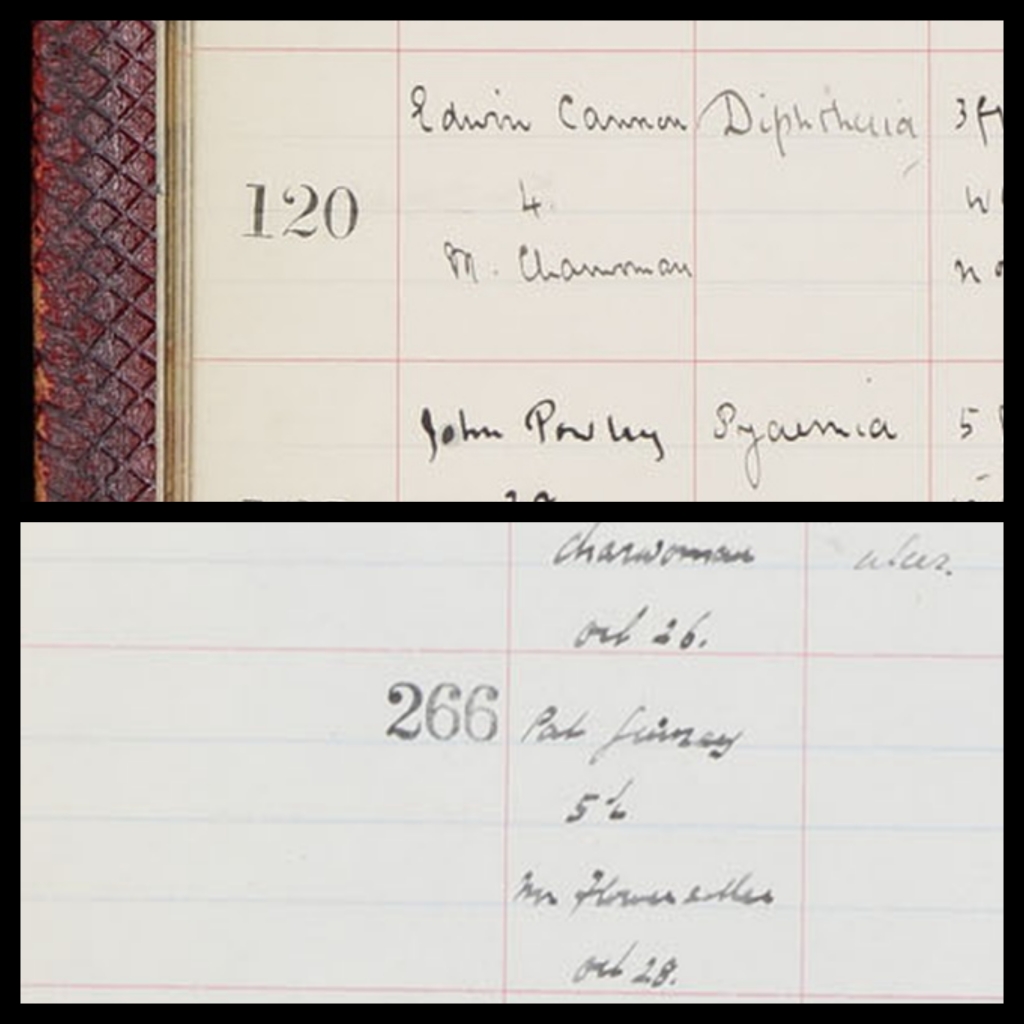 Index to the post mortem volume 1887, showing the entry for Edwin Cannon, PM/1887/120, and index to the post mortem volume 1917, showing the entry for Pat Gurney, PM/1917/266. Post Mortem Casebooks, Archives and Special Collections, St George’s, University of London
Index to the post mortem volume 1887, showing the entry for Edwin Cannon, PM/1887/120, and index to the post mortem volume 1917, showing the entry for Pat Gurney, PM/1917/266. Post Mortem Casebooks, Archives and Special Collections, St George’s, University of London
This was also the time when St George’s Medical School allowed its first female students, several of whom went on to work at the hospitals, including on the post mortems. Mostly, however, women’s status was defined by that of their husband or father; they are designated as ‘wife of labourer’, ‘wife of coachman’, or simply ‘married’, ‘wife’ or ‘widow’. And looking more closely into the cases it is soon obvious why this would be. Lack of (knowledge of) contraception as well as the social unacceptability of it meant that many women spent much of their lives pregnant, breastfeeding and caring for their children – they simply did not have the chance to even consider working outside the home. Emma Rickets, 50, is recorded as having had 22 children in 1888 – and having been one of 22 herself. That is of course an extreme example – but 10 children is not uncommon, and surely much fewer would have been stressful enough. Maria Cooper was 27 when she died in 1860; she is noted to have been married at 15 and borne nine children before her untimely death.
Another aspect of 19th century life the post mortems reveal is social and geographical mobility. Sarah Black was only 15 years old when she died of tuberculosis. She is described as being a kitchen maid, and her medical case notes tell us that she had come to London from Argyleshire two years previously, presumably to find work in the city. The doctor notes that ‘She was a dark-haired Highland girl with a fair skin’.
Soldiers and sailors make occasional appearances in the records, often in the form of men who had perhaps gone ‘to sea’, often in East India Company’s employ, and latterly returned to Britain from the colonies. James Scott, for instance, died aged 44 in 1881. His occupation is listed as a confectioner, but his medical case notes tell us that he had gone to sea aged 17 in East India Company’s service, and had suffered from dysentery whilst in India. Life at sea is laid bare in the description of Scott as ‘a very heavy drinker of spirits, especially 1858-1870 when he had much morning vomiting & depression’.
Far fewer are references to people who made the journey in the other direction: John Lusila was only 23 when he died in 1854 of tuberculosis. His medical record notes that ‘This poor black, who was a native of Angola, and had been in the West Indies, had been 10 years in England, & was a waiter in an eating house’.
 Post mortem record of John Lusila, 17 Dec 1854, PM/1854/384. Post Mortem Casebooks, Archives and Special Collections, St George’s, University of London
Post mortem record of John Lusila, 17 Dec 1854, PM/1854/384. Post Mortem Casebooks, Archives and Special Collections, St George’s, University of London
From the Napoleonic wars in the early 19th century to the First World War, the post mortems record soldiers, their wives and their children. In the visualisation of the occupations in 1918, the armed forces has become the largest category: there are soldiers, privates, riflemen, sergeants, a captain, a naval commander and an admiral – and in particular their wives and children, who of course were the ones remaining in London.
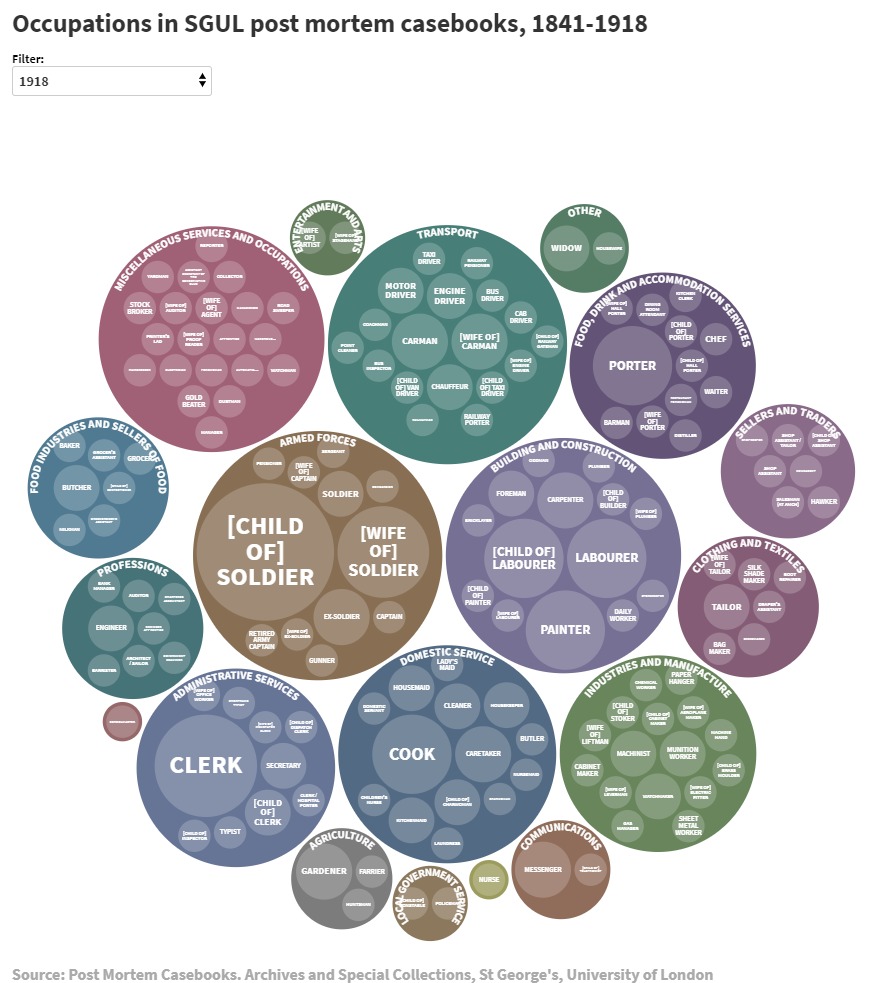 Occupations in SGUL post mortem examination books, 1917. Source: Post Mortem Casebooks, Archives and Special Collections, St George’s, University of London. By Juulia Ahvensalmi
Occupations in SGUL post mortem examination books, 1917. Source: Post Mortem Casebooks, Archives and Special Collections, St George’s, University of London. By Juulia Ahvensalmi
Not everyone was, however employed: unemployment was also a problem, and with no social security available apart from poor houses and charity hospitals, unemployment often meant destitution. The case notes of Samuel Brooks, 24, tell us that at the time of his admission to the hospital suffering from tuberculosis, ‘he had been out of work a long time, & starving, that he had recently found employment, and it was supposed he had been unequal to his task. He had been ailing for a fortnight, and had been entirely laid up for a week’. William Chant committed suicide in 1887, aged 57, after a period of unemployment; his notes tell us that ‘in consequence [he] had got very depressed’.
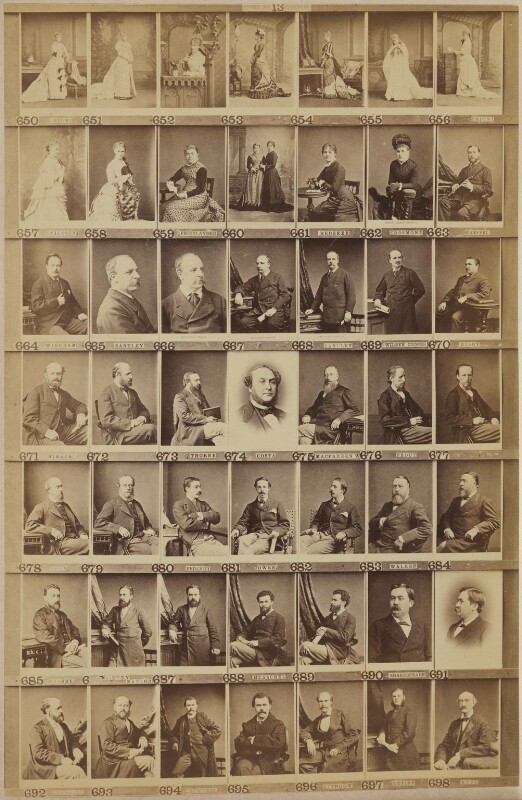 Hélène Crosmond-Turner in Various musical celebrities by and after Elliott & Fry bromide print, 1890s. NPG Ax139913 © National Portrait Gallery, London
Hélène Crosmond-Turner in Various musical celebrities by and after Elliott & Fry bromide print, 1890s. NPG Ax139913 © National Portrait Gallery, London
One of the interesting categories are those working in arts and entertainment. There are not many, but they include Percy Vaughan, a comedian, who died of tuberculosis aged 29 in 1887. His medical case records laconically that ‘he had been a pantomimic actor & had lived hard and fast’.
Another tragic story is that of an opera singer, Hélène Crosmond-Turner. Born Rosa Levison or Leverson, she shot herself in a cab on Piccadilly in 1888 after failing to renew her contract as a lead in Aïda. She had for some time been worried about her financial situation and her career, and had tried some days previously to overdose on painkillers. The papers made much of this dramatic suicide, including describing her dress in detail – red and brown stripes, with a black and brown checked ulster, trimmed with imitation beaver (‘not one of her best outfits, as her landlady Mrs Godbold later observed’).
Part of the attention lavished at poor Hélène following her death was due to her famous mother, Madame Rachel, whose tagline was ‘beautiful forever’. From selling rabbit skins and used clothes in London’s East End, Rachel proceeded to be the owner of a very profitable beauty salon in Mayfair. Her famous cosmetics, however, contained a multitude of toxic chemicals, including prussic acid, lead and arsenic. This, alongside with allegations of blackmailing her clients, led her to being prosecuted for fraud. She died in Woking jail in 1880, aged 60, eight years before her daughter.
Those working in the hospitality industry in particular were often assumed to be heavy drinkers, and the doctor treating David Ferguson, 45, in 1888 notes that ‘He was a butler but claimed to be considered temperate’, whilst George Carter’s, 45, medical record in 1860 states that ‘This man was an omnibus driver of drunken habits, like most of his class’.
Some positions also came with certain benefits, as we learn from the case of George Courtenay, 38, in 1860: ‘He was a very sober man, though he partook freely of the beer which was allowed in unlimited quantity to the servants’ (sobriety is also a relative concept).
Accidents and diseases are frequently a direct consequence of people’s occupations, and the post mortems enable the tracking of occupational diseases.
Painters often suffered from colic, or lead poisoning, and paper stainers also frequently dealt with toxic substances: John Hyland, 48, is noted as having handled during his working life ‘much lead, arsenic, copper & mercury’ – a paper stainer would have worked with wallpaper, which, due to its vivid colours, was notoriously deadly in the Victorian era.
Falling off scaffolding or ladders is a frequent cause of death for builders, and in 1888 we find the case of Aaron Gatheridge, 53, who, as a carpet layer, had ‘swallowed many nails and tacks’ (he died of cancer of the pylorus).
It’s not always clear what category is most appropriate to use for various occupations – unless the record explicitly states that someone works for instance as a servant at a hotel, rather than at a private house, it is impossible to know. ‘Servant’ has therefore been classified as ‘domestic service’, with the caveat that this might not exclusively be the case.
The category ‘miscellaneous services and occupations’ include what it says on the tin – a selection of occupations that do not fit neatly the other categories, often because they were rare within the data, or because it is not clear which category they should belong in. The latter category includes things like apprentices (who were they apprenticed to?) and collectors (what exactly were they collecting?).
Amongst them there is a wonderful array of occupations: there’s a mosaic worker from 1870, an assistant secretary of the Conservative Club from 1918, a piano forte maker from 1877, a keeper of urinal from 1858, a sword polisher from 1888 and a cats’ meat man from 1858. The latter would have sold meat for cats, probably walking around the streets with a cart (one can only imagine the cats trailing after him!). Rosa Blacker in 1858 is ‘Clergyman’s daughter’, and Louisa Lee in 1887 is just described as ‘gypsey’ (there would also be a lot to say about the use of language in the records, often startling and offensive to the modern reader).